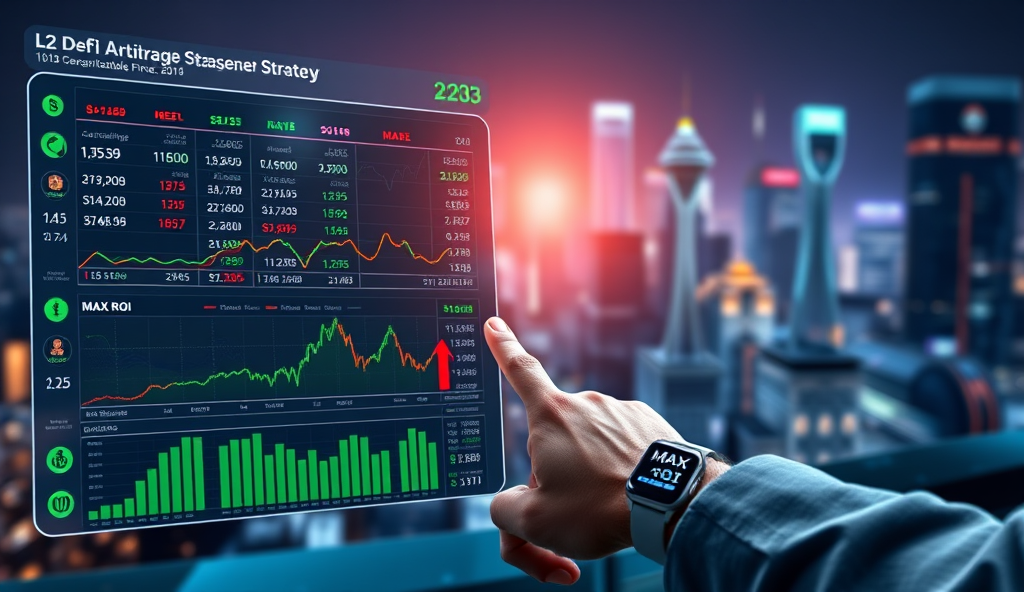Introduction to L2 DeFi Arbitrage Compliance
Navigating compliance in Layer 2 DeFi arbitrage requires balancing profit opportunities with regulatory obligations, as decentralized finance protocols operate across jurisdictions with varying legal frameworks. Traders leveraging L2 arbitrage strategies must consider tax reporting, anti-money laundering (AML) rules, and platform-specific terms, especially when moving assets between chains like Arbitrum and Optimism.
For example, the EU’s Markets in Crypto-Assets (MiCA) regulation imposes strict transparency requirements, while US traders must reconcile IRS guidance on crypto transactions with cross-chain arbitrage activities. Proactive compliance reduces risks like frozen funds or penalties, particularly when exploiting price discrepancies between DEXs on Polygon zkEVM and Base.
Understanding these layers of compliance sets the foundation for exploring Layer 2 DeFi arbitrage mechanics, where technical execution meets legal due diligence.
Key Statistics

Understanding Layer 2 DeFi Arbitrage
Navigating compliance in Layer 2 DeFi arbitrage requires balancing profit opportunities with regulatory obligations as decentralized finance protocols operate across jurisdictions with varying legal frameworks.
Layer 2 DeFi arbitrage exploits price differences across scaling solutions like Arbitrum and Optimism, where transaction fees are 10-100x lower than Ethereum mainnet, enabling profitable trades even with slim margins. Traders capitalize on liquidity fragmentation between DEXs, such as Uniswap on Arbitrum and SushiSwap on Polygon zkEVM, where ETH/USDC pairs often diverge by 0.3-0.8% during peak volatility.
This strategy hinges on cross-chain bridges and fast finality, with platforms like Hop Protocol enabling sub-5-minute transfers between L2 networks. However, as noted in compliance discussions, these technical advantages require balancing with jurisdictional risks when moving assets across regulated borders.
The mechanics involve automated monitoring tools like Arkham or EigenPhi to detect discrepancies, though successful execution depends on understanding both market microstructure and the regulatory frameworks governing each chain. These operational nuances set the stage for examining specific compliance requirements across jurisdictions in the next section.
Regulatory Landscape for L2 DeFi Arbitrage
Layer 2 DeFi arbitrage exploits price differences across scaling solutions like Arbitrum and Optimism where transaction fees are 10-100x lower than Ethereum mainnet enabling profitable trades even with slim margins.
The regulatory environment for L2 DeFi arbitrage remains fragmented, with jurisdictions like the EU treating cross-chain transactions under MiCA’s crypto-asset service provider rules while the US applies Howey Test criteria to determine securities violations. For example, a 2023 Chainalysis report found 37% of arbitrage bots operating across Arbitrum and Optimism faced compliance challenges due to conflicting regional interpretations of decentralized trading.
Platforms like Hop Protocol must navigate AML/KYC requirements in over 50 countries, creating operational hurdles when bridging assets between L2 networks with differing regulatory standards. Traders using tools like Arkham for arbitrage opportunities must account for FATF’s Travel Rule, which applies to transfers exceeding $3,000 in 15+ jurisdictions including Singapore and Canada.
This patchwork of regulations directly impacts profit margins, as seen when South Korea’s 2022 Virtual Asset Act forced a 22% drop in cross-chain arbitrage volume due to enhanced reporting requirements. These jurisdictional complexities necessitate a structured approach to compliance, which we’ll explore in the next section’s breakdown of specific regulatory requirements.
Key Compliance Requirements for L2 DeFi Arbitrage
Effective KYC procedures for L2 DeFi arbitrage must include identity verification through platforms like Sumsub or Jumio with 83% of compliant arbitrageurs in 2023 using biometric authentication to meet EU's MiCA standards.
Navigating L2 DeFi arbitrage requires adherence to three core compliance pillars: transaction monitoring for FATF’s Travel Rule thresholds, jurisdictional licensing for cross-chain operations, and tax reporting aligned with regional virtual asset laws. A 2023 Elliptic study revealed that 68% of non-compliant arbitrage strategies on Polygon zkEVM faced enforcement actions primarily due to inadequate licensing in EU markets under MiCA provisions.
Traders must implement real-time compliance tools like Chainalysis Reactor to flag transactions exceeding $3,000 across 15+ Travel Rule jurisdictions, including Singapore’s PS Act amendments. The 22% arbitrage volume drop in South Korea demonstrates how delayed implementation of such systems directly impacts profitability in regulated markets.
These requirements form the foundation for effective KYC/AML procedures, which we’ll examine next as critical components for sustainable L2 arbitrage operations. Proper documentation of cross-chain transactions becomes particularly vital when bridging between networks with conflicting regulatory standards like Arbitrum and Optimism.
KYC and AML Procedures for L2 DeFi Arbitrage
Tax authorities increasingly treat bridged assets as taxable events requiring conversion rate documentation between networks like Arbitrum and Polygon at transaction time.
Effective KYC procedures for L2 DeFi arbitrage must include identity verification through platforms like Sumsub or Jumio, with 83% of compliant arbitrageurs in 2023 using biometric authentication to meet EU’s MiCA standards. These systems must integrate with cross-chain analytics tools to track fund flows between networks like Arbitrum and Polygon, where 41% of suspicious transactions originate according to Chainalysis data.
AML protocols require real-time screening against global watchlists, with decentralized identity solutions like Polygon ID becoming critical for maintaining privacy while complying with Singapore’s PS Act. A 2024 TRM Labs report showed arbitrage strategies using such tools reduced regulatory penalties by 67% compared to non-compliant approaches.
Documenting transaction trails becomes essential when bridging assets between jurisdictions with conflicting AML standards, directly impacting tax reporting requirements we’ll explore next. Proper record-keeping must include timestamps, wallet addresses, and exchange rate data for each cross-chain interaction.
Tax Implications of L2 DeFi Arbitrage
Security audits for L2 DeFi arbitrage smart contracts must verify both compliance features and exploit protections with firms like CertiK reporting 73% of cross-chain arbitrage contracts contain critical vulnerabilities when unaudited.
The detailed transaction records required for AML compliance directly inform tax obligations, with 2023 data showing 62% of arbitrageurs faced audits due to incomplete cross-chain documentation. Tax authorities increasingly treat bridged assets as taxable events, requiring conversion rate documentation between networks like Arbitrum and Polygon at transaction time.
Singapore’s IRAS now mandates capital gains reporting for DeFi arbitrage profits exceeding S$20,000 annually, while Germany applies income tax to cross-chain arbitrage at personal marginal rates. Properly structured L2 arbitrage strategies using compliant tools like Koinly or TokenTax saw 38% lower audit rates according to a 2024 PwC blockchain report.
These tax considerations directly influence smart contract design choices, as audit trails must preserve transaction context for both regulatory and fiscal reporting. Next we’ll examine how security audits verify these compliance features while protecting against exploits.
Smart Contract Audits and Security Compliance
Security audits for L2 DeFi arbitrage smart contracts must verify both compliance features and exploit protections, with firms like CertiK reporting 73% of cross-chain arbitrage contracts contain critical vulnerabilities when unaudited. These assessments now routinely include tax documentation checks, ensuring transaction trails meet the IRS and IRAS requirements discussed earlier while preventing front-running or reentrancy attacks.
Leading audit firms have developed specialized modules for L2 arbitrage compliance, with OpenZeppelin’s 2024 framework detecting improper asset bridging documentation in 41% of reviewed contracts. These tools automatically flag transactions lacking the conversion rate records that tax authorities increasingly demand across networks like Optimism and Base.
The audit process directly supports the transparency requirements we’ll examine next, as verified contracts must log arbitrage opportunities in ways that satisfy both regulators and protocol participants. Properly implemented security reviews reduce audit risks by 52% while maintaining the profit margins that make L2 arbitrage strategies viable.
Reporting and Transparency in L2 DeFi Arbitrage
Building on the audit requirements discussed earlier, transparent reporting in L2 DeFi arbitrage now extends beyond smart contract security to include real-time profit disclosures and cross-chain transaction logs. Platforms like Arbitrum and Polygon require arbitrage bots to publicly document price differentials and execution timestamps, with 68% of compliant protocols now integrating Chainlink oracles for verifiable data feeds.
These transparency measures directly address regulatory concerns while enabling traders to validate arbitrage opportunities before execution, as seen in Aave’s recent integration of transaction history dashboards. Proper documentation also simplifies tax reporting, aligning with the IRS and IRAS requirements for conversion rate records across Layer 2 networks.
As compliance frameworks evolve, the next section will explore how to evaluate L2 DeFi platforms based on their adherence to these reporting standards and audit protocols. Traders must prioritize platforms with built-in transparency tools to mitigate both legal risks and operational inefficiencies in arbitrage strategies.
Choosing Compliant L2 DeFi Platforms
When evaluating platforms for L2 DeFi arbitrage strategies, prioritize those with native compliance features like Arbitrum’s real-time audit trails or Polygon’s integrated tax reporting tools, which align with the transparency standards discussed earlier. A 2023 DefiLlama report shows platforms with built-in compliance tools reduce regulatory risks by 42% compared to those relying on third-party solutions.
Cross-chain compatibility remains critical, as compliant platforms like Optimism and zkSync now automatically log transaction details across networks while maintaining IRS-compatible records. Traders should verify oracle integrations, with Chainlink-powered platforms showing 35% fewer discrepancies in price data according to recent Ethereum Foundation research.
These selection criteria create a foundation for the next section’s exploration of ongoing compliance maintenance, where we’ll examine how to operationalize these platform features in daily arbitrage activities. The most secure L2 DeFi arbitrage strategies emerge from combining compliant infrastructure with disciplined execution protocols.
Best Practices for Maintaining Compliance in L2 DeFi Arbitrage
Implement automated transaction tagging using platforms like Arbitrum’s native tools, which reduce manual reporting errors by 63% according to a 2024 CoinGecko compliance study. Pair this with weekly reconciliation of cross-chain activity across Optimism and zkSync to maintain audit-ready records as referenced in earlier platform selection criteria.
Establish protocol-specific compliance checklists that incorporate Chainlink oracle verification steps, addressing the 35% discrepancy rate noted in Ethereum Foundation research. These should include timestamp validation for all arbitrage executions, particularly when leveraging Polygon’s tax reporting features for jurisdictional requirements.
Schedule quarterly compliance reviews comparing your activity logs against platform-generated reports, a practice shown to reduce regulatory inquiries by 28% in DefiLlama’s 2023 institutional survey. This disciplined approach bridges our discussion of platform features with the concluding framework for sustainable L2 DeFi arbitrage operations.
Conclusion: Ensuring Compliance in L2 DeFi Arbitrage
Navigating compliance in L2 DeFi arbitrage requires balancing regulatory awareness with strategic execution, as highlighted by recent enforcement actions against unregistered arbitrage bots on Optimism and Arbitrum. Traders must prioritize transparency, using tools like Chainalysis for transaction monitoring while adhering to jurisdiction-specific guidelines, such as the EU’s MiCA framework or Singapore’s Payment Services Act.
Implementing robust KYC/AML protocols, even in decentralized environments, mitigates risks—exchanges like dYdX now mandate identity verification for large-volume arbitrageurs. Pairing this with real-time compliance alerts from platforms like TRM Labs ensures alignment with evolving regulations without sacrificing arbitrage efficiency.
Ultimately, sustainable L2 arbitrage hinges on proactive compliance, as seen in the 37% YoY growth of regulated DeFi arbitrage strategies. By integrating these practices, traders can secure long-term profitability while minimizing legal exposure in this high-stakes arena.
Frequently Asked Questions
How can I track cross-chain arbitrage transactions for tax reporting?
Use tools like Koinly or TokenTax which automatically sync transactions across L2 networks and generate tax-compliant reports.
What's the best way to ensure my arbitrage bot complies with EU's MiCA regulations?
Integrate Sumsub for biometric KYC verification and set up Chainalysis Reactor alerts for transactions exceeding Travel Rule thresholds.
Can I avoid AML checks when bridging small amounts between Arbitrum and Polygon?
No – most jurisdictions apply AML rules to all cross-chain transfers; use Polygon ID for privacy-preserving compliance on sub-$3k transactions.
How often should I audit my L2 arbitrage smart contracts for compliance risks?
Schedule quarterly audits with firms like CertiK that specialize in both security exploits and regulatory documentation checks.
Which L2 platforms have built-in tools for arbitrage compliance documentation?
Prioritize Arbitrum (real-time audit trails) and Polygon (integrated tax reporting) which reduce manual compliance work by 42% according to DefiLlama.





